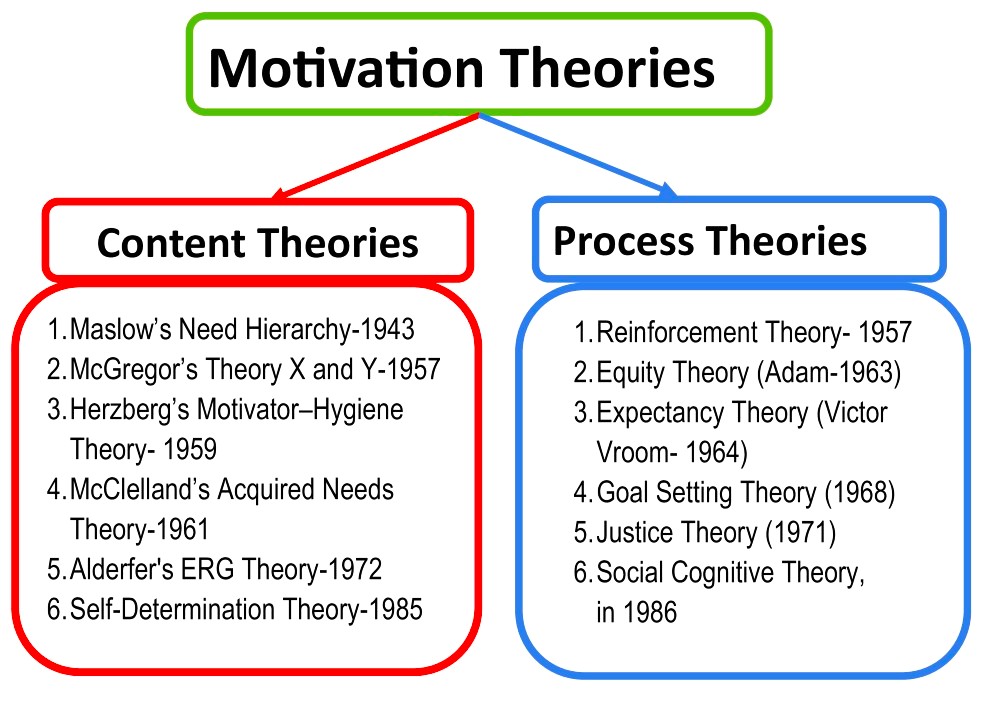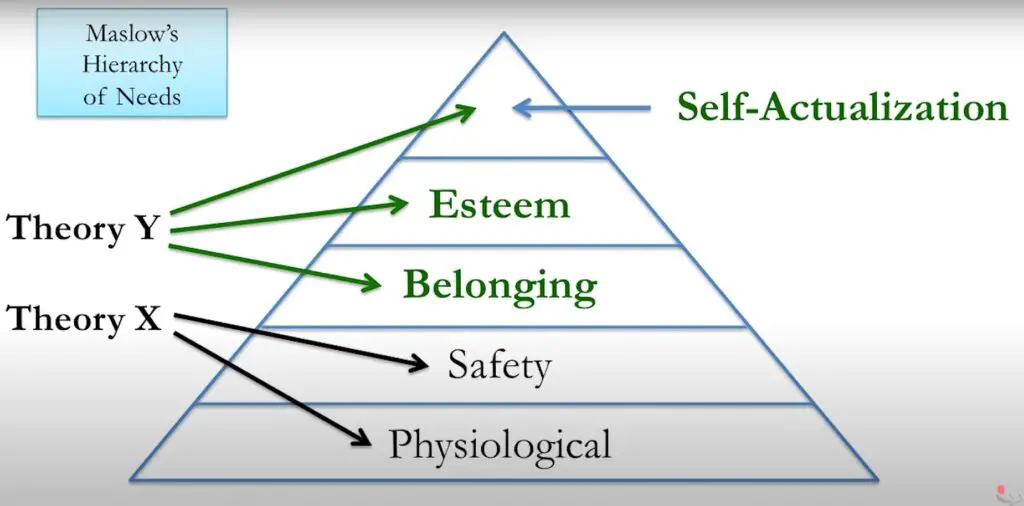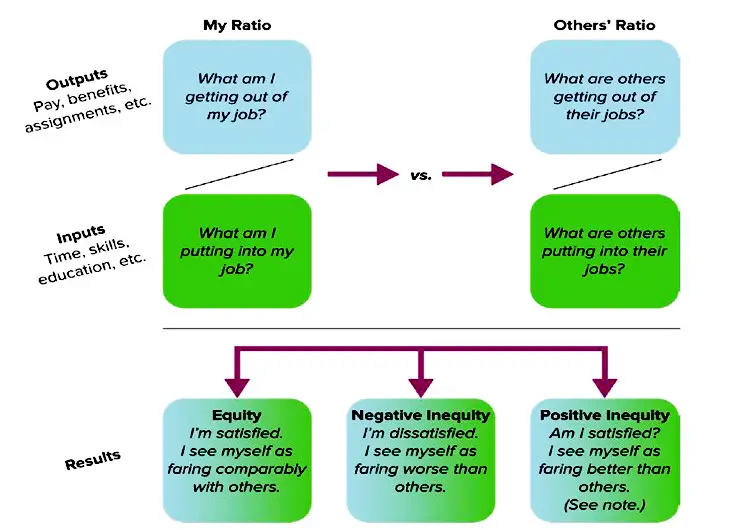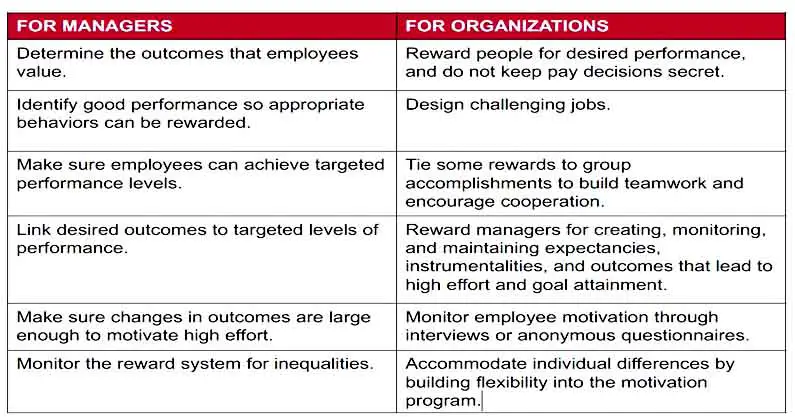This article includes the following key phrases: Content and Process Theories of Motivation. The List of Content and Process Theories of Motivation with Examples. Difference Between Content and Process Theories of Motivation in Psychology and Organizational Behavior.
Content and Process Theories of Motivation
Content and process theories of motivation refer to the two different types of frameworks that explain what factors and how factors motivate individuals to keep working in personal and organizational contexts. Indeed, these theories discuss which factors influence humans to improve job performance and how they continuously keep motivated. The content and process theories are the most common and famous models to motivate employees to receive better outcomes.
Content theories are those researchers who explain what factors are behind people’s or employees’ motivation to continuous performance in the workplace.
In contrast, process theories refer to the frameworks that are designed to explain how factors work behind people’s or employees’ motivation for continuous performance in the workplace.
Types of Motivation Theories
The content and process theories are categories of motivational models such as Maslow’s needs theory, McGregor’s theory X and Y, Equity theory, Expectancy theory, and so more. These are the most common classifications of motivational theory in psychology and organizational behavior.

Difference Between Content and Process Theories of Motivation
Content Theories of Motivation
Content theories of motivation are designed to represent the external and internal factors, including needs, aspirations, and satisfactions that influence humans to keep working in personal, social, and organizational life. So in an organizational context, content theory focuses on employees’ needs and gratification that encourages them to perform in the workplace.
Content theories find the answers to the question “What factors drive human behavior?”. Content theory assumes people have a set of needs that they are intended to achieve.
Example of Content Theories of Motivation
The examples of content theories of motivation are:
- Maslow’s Need Hierarchy (Abraham Maslow-1943)
- McGregor’s Theory X and Theory Y (Douglas McGregor-1957)
- Herzberg’s Motivator–Hygiene Theory (Frederick Herzberg – 1959)
- McClelland’s Acquired Needs Theory (David McClelland- 1961)
- Alderfer’s ERG Theory of Motivation (Clayton Alderfer- 1972)
- Self-Determination Theory (Deci and Ryan-1985)
Process Theories of Motivation
The process theory explains how factors motivate people to achieve goals or stop them from trying to achieve the targets. These theories are frameworks that explore the process of motivation. Process theories of motivation are designed to explain how people’s behavior is directed and organized, sustained, or adjourned.
Process theories are set to seek the answers to the question “How do factors direct individual behavior?”. Theory assumes people have independent and interdependent goals; therefore, they design a concise way to achieve them. It explains the way or process of how they get motivated compared to the factors that inspire them.
Example of Process Theories of Motivation
The examples of Process theories of motivation are:
- Equity Theory (Adam-1963)
- Expectancy Theory (Victor Vroom- 1964)
- Goal Setting Theory (1968)
- Justice Theory (1971)
Content Theories of Motivation Examples
1. Maslow’s Hierarchy of Needs Theory
American psychologist Abraham Maslow developed Maslow’s hierarchy of needs theory in 1943 in his paper named “A Theory of Human Motivation: The five needs of Maslow’s hierarchy theory are Physiological needs, Safety needs, Love and belongingness needs, Esteem needs, and Self-actualization needs. The first four needs are deficiency needs (D-needs), and the top level is growth or being needs (B-needs).

2. McGregor’s Theory X and Theory Y
American Psychologist Douglas McGregor proposed the prominent theory X and theory Y In 1957 in the book titled “The Human Side of Enterprise”. Theory X and Theory Y refer to two different styles of management in an organization and employees’ characteristics differ from one another. The employees and managers hold different types of organizational behaviors and traits.

Theory X Management
The management believes that the average employee in the organization is lazy and doesn’t like to take workloads.
These employees have little skills, experience, and ambitions; hence, managers need to force them to work regularly. They come to the office late and try to leave the workplace early. The employees in theory X management procrastinate in submitting reports and dislike assisting coworkers to complete the task on time. Employees, always find a way to avoid complex tasks to do. However, they are focused on lower-level needs like salary, financial security, and punishment.
Therefore, the strategy of theory, X management is controlling and output driving approach.
Theory Y Management
Theory Y management assumes that the average employee in the organization prefers to work spontaneously. Employees like to work without being asked and take workloads when the organization demands it. They earn gratification from assigned tasks and responsibility. Employees are responsible and helpful to each other. They are focused on high-level needs including recognition, achievements, and honors from coworkers and organizations.
The management strategy of theory Y enhances empowerment and a trust-driven approach.
Difference Between Theory X and Y Employees
Employees of Theory X
- Employees hold pessimistic views with little optimism toward organizations.
- They dislike work; therefore managers must monitor them.
- Employees can only be motivated by money and punishments.
Employees of Theory Y
- Employees hold an optimistic set of assumptions in the organizations.
- They are self-engaged, committed, responsible, and creative.
- Recognitions, achievements, and honors can motivate employees to improve job performance.
3. Herzberg’s Two Factor Motivator–Hygiene Theory (1959)
Frederick Herzberg proposed the two-factor theory of motivation in 1959. Job satisfaction and dissatisfaction arise from two different sets of factors such as motivation and hygiene. Based on Maslow’s pyramid of needs theory published in 1943, Frederick Herzberg theorized this framework by adding Motivation-hygiene factors that motivate employees.
The motivating factors increase employees’ job satisfaction whereas hygiene factors prevent employees from being dissatisfied. The hygiene factors transform employees’ state of dissatisfaction into no satisfaction (neutral position) while in contrast, motivator factors make employees’ state of no satisfaction into satisfaction.
Elements of the Two-Factor Theory of Motivation are:
- Motivation (Intrinsic Factors)
- Hygiene (Extrinsic Factors)
Motivation (Intrinsic Factors)
Motivation includes intrinsic factors that boost job satisfaction among employees in the organization. The motivational factors include recognition, challenging tasks, achievements, Power, responsibilities, affiliation, relatedness, and opportunities. These intrinsic factors make employees feel an influential sense of decision-making in the organization. This continuous motivation arises from the job itself. Motivation may drive a person to move from a state of no satisfaction to satisfaction.
Hygiene (Extrinsic factors)
In contrast, Hygiene comprises extrinsic factors that prevent employees from being dissatisfied. The hygiene (extrinsic) factors are lower-level needs such as salary, job security, status, work environments, policy, and legal compliance. The presence of Hygiene factors may influence an employee to move from a state of dissatisfaction to no dissatisfaction.
How To Use Two-Factor Theory in Organization
The top managers and senior employees ensure hygiene factors such as work environments to prevent employees from being dissatisfied and enhance the motivator factors such as recognition to improve job satisfaction.
4. McClelland’s Theory of Needs (1961)
In 1961, David McClelland developed the Need Theory explaining three factors that motivate people in organizations. He proposed the Acquired- Needs Theory in his book ‘The Achieving Society’.
Apart from Maslow’s hierarchy of five needs (Physiological needs, Safety needs, Love and belongingness needs, Esteem needs, and Self-actualization), McClelland proposed three additional needs (needs for achievement, affiliation, and power) that inspire employees to work in the organization. Therefore, the three needs theory is a content theory; because it explores three more motivational factors in organizational behavior.
David McClelland’s Three Needs are:
-
Needs For Achievement (n-Ach)
- Prefers working on challenges.
- Best in situations in which performance is due to effort and ability.
- Prefers to work with other high achievers
-
Needs For Affiliation (n-Aff)
- Likes to work in teams with cooperation and collegiality.
- Tends to avoid conflict.
- Likes to achieve complimentary in private.
-
Needs For Power (n-Pow)
- Likes to be in charge.
- Likes to be in control of people and events.
- Appreciates being recognized.
5. Alderfer’s ERG Theory of Motivation (1972)
Clayton Alderfer proposed the ERG theory of motivation in 1972 by extending Maslow’s hierarchy of needs. Alderfer argued that human needs are divided into three categories instead of the five categories proposed by Abraham Maslow.
According to Alderfer(1972), the three needs factors of human motivation are Existence, Relatedness, and Growth. The motivation factor existence contains physiological needs including food, water, shelter, sex, air, clothes, and physical and mental safety. The organization meets these needs with salary, incentives, job security, and good working conditions ensuring hygiene factors.
The need factor relatedness includes love, belongings, respect, mental and physical support, and communication engagement. The organization can ensure relatedness among employees by improving interpersonal communication.
The final factor of the ERG theory of motivation is growth which enhances personal and group achievement.
6. Self-Determination Theory (1985)
Deci and Ryan proposed the self-determination theory in 1985 in a book named “Intrinsic Motivation and Self-determination in Human Behavior”. It is known as SDT in human and organizational behaviors. Self-determination theory assumes that three innate needs influence an employee’s behavior and well-being. This theory argues that competence, autonomy, and relatedness are the most powerful factors behind employee motivation to enhance performance, continuous and creativity.
The Three Motivational Factors of Self-Determination Theory are:
- Competence
- Autonomy
- Relatedness.
Competence, Autonomy, and Relatedness are intrinsic motivations or needs that inspire employees to work continuously. Therefore, self-determination theory (SDT) is a content theory of motivation.
How To Use Self-Determination Theory in an Organization
Managers should influence behavior by creating work environments that support each need.
- Firstly, the management needs to provide tangible resources, time, contacts, and coaching to improve employees’ competence.
- Secondly, the organization has to focus on empowering employees and delegating meaningful assignments and tasks to enhance feelings of autonomy.
- Finally, the senior employees have to make fun and companionship to foster relatedness.
Lower-level and higher-level Needs of Content Theories of Motivation
Process Theories of Motivation Examples
- Equity Theory (Adam-1963)
- Expectancy Theory (Victor Vroom- 1964)
- Goal Setting Theory (1968)
- Justice Theory (1971)
1. Adam’s Equity Theory (1963)
John Stacey Adams proposed equity theory in 1963 to explain how individuals strive for fairness and justice in an organizational context. Adam’s equity theory explains the process of motivation; therefore, it is a process theory. Equity theory determines the resources provided by organizations for employees and the outcome ratio received from them. It is a give-and-take relationship like reciprocity.
According to Adams’ Equity Theory (1963), a fair balance between employees’ input and output factors motivates employees to enhance productivity. A strong and positive relationship between employees and organizations yields better outcomes.
The input factors of equity theory comprise employees’ dedication, hard work, effort, skill, experience, enthusiasm, and so more.
The output elements of equity include salary, respect, acknowledgment, recognition, and more.

The model is based on our evaluation and comparison of outputs and inputs with relevant others.
2. Vroom Expectancy Theory (1964)
Victor H. Vroom proposed the expectancy theory of motivation in 1964 with three elements: expectancy, instrumentality, and valence. It is a process theory of motivation that demonstrates the process of motivation. People are motivated to behave in ways that produce desired combinations of expected outcomes.

The Elements of Expectancy Theory are:
- Expectancy
- Instrumentality
- Valence
Expectancy (Efforts)
The expectancy factor of Vroom expectancy theory refers to the employees’ anticipation that if they make efforts to complete the job, they will achieve performance goals. For example, the employee has to sell 100 phones to achieve the monthly product selling goal. To achieve the monthly goal set by the company, employees continuously keep trying.
Expectancy finds the answers to the question “Can I achieve my target if I work hard?”
Instrumentality (Performance)
Instrumentality is the employees’ belief that they will receive the expected outcome if their performance meets the demands. For example, the employee will get rewards if they achieve the target. The expected outcome might come with a salary increment, promotion, and recognition.
Expectancy sees the answers to the question “Will I get rewards if I can achieve the target?”
Valence (Outcome)
Valence refers to the perceived value of received rewards from the organization.
Expectancy sees the answers to the question “Will I become happy if I get the particular reward?”
Vroom Expectancy Theory Organizational Implication

The Use of Expectancy Theory To Evaluate How Does Pay Influence Individual Employees?
- Expectancy theory emphasizes expected rewards.
- Compensation mainly influences instrumentality.
Extrinsic Motivation:
- Depends on rewards (such as pay and benefits) controlled by external sources.
Intrinsic Motivation:
- Depends on rewards that flow naturally from work itself.
- Extrinsic incentives generally do not harm intrinsic motivation.
3. Goal Setting Theory (1968)
In 1968, Professor Edwin Locke proposed the goal-setting theory explaining that clear goals and feedback are crucial to employee motivation. This theory has been well accepted by the economic and organizational sectors to determine the human motivation process.
In 1990, Edwin Locke and Gary Latham extended the goal-setting theory articulating five principles of goal-setting in organizations.
According to Locke and Latham’s goal-setting theory published in 1990, the five principles that inspire employees are:
- Clarity
- Challenge
- Commitment
- Feedback
- Task complexity
Certain conditions are necessary for goal setting to work.
- People must have the ability and resources.
- People need to be committed to the goal.
Performance feedback and participation in deciding how to achieve goals are necessary but not sufficient. Goal achievement leads to job satisfaction.
Mechanisms Behind the Power of Goal Setting
- Goals regulate effort.
- Goals direct attention.
- Goals increase persistence.
- Goals foster task strategies and action plans.
4. Justice Theory (1971)
The American Philosopher John Rawls proposed the Justice Theory in 1971. Organizational justice refers to the extent to which people perceive that they are treated fairly at work. Three types of justice: 1. Distributive Justice. 2. Procedural Justice. 3. Interactional Justice.
Using Equity and Justice Theories
- Employee perceptions
- Employees want a voice in decisions that affect them.
- Employees should have an appeals process.
- Leader behavior
- A climate for justice makes a difference.
References
| Adams, J. S. (1963). Towards an understanding of inequity. The Journal of Abnormal and Social Psychology, 67(5), 422–436. https://doi.org/10.1037/h0040968
Deci, E. L., & Ryan, R. M. (1985). The general causality orientations scale: Self-determination in personality. Journal of research in personality, 19(2), 109-134. Locke, E. A. (1968), Toward a theory of task motivation and incentives, Organizational Behavior and Human Performance, 3(2): 157-189 Locke, E.A. and Latham, G. P. (1990), A theory of goal setting and task performance, Prentice Hall College Locke, E.A. and Latham, G. P. (2013), New developments in goal setting and task performance, Routledge |